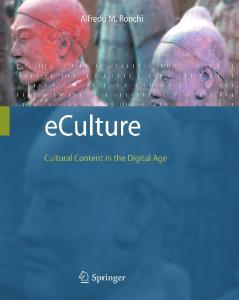A Cultural Memory of the Digital Age?
- PDF / 577,474 Bytes
- 14 Pages / 439.37 x 666.142 pts Page_size
- 18 Downloads / 363 Views
A Cultural Memory of the Digital Age? Dario Henri Haux1 · Antoinette Maget Dominicé2 · Jana Alexandra Raspotnig2 Accepted: 16 September 2020 © The Author(s) 2020
Abstract Considering digital cultural heritage as the digitalized assets from memory institutions and digital born art, this paper aims to build on its current normative definitions. This first notion addresses the subtle, yet complex relationship between technology and culture. In addition, we consider the criteria set for defining heritage in memory theorization. By doing so, we want to challenge the lack of uniform standards and approaches in dealing with digital cultural heritage and to give Aleida and Jan Assmann’s Theory of Cultural Memory a normative dimension. Can there be a cultural memory of the digital age? Keywords Digital cultural heritage · Cultural memory · Digital practices · Law & humanities
1 Introduction Our everyday life is shaped by digital technologies. Becoming unavoidable, we encounter them in all contexts. In the world of culture, the rises of digital initiatives within museums, galleries, libraries and other memory institutions allow to (partially) visit museums and/or temporary exhibitions, to access heritage resources. In some way, some of these heritage institutions furthermore open up the possibility of reusing parts of the works. Digitized cultural assets kept in public and private collections can be downloaded and edited, while artists are creating art from digital devices or integrate tech gadgets and images in installations [1]. By the beginning of 2020, with the rise of COVID-19, these developments have become a new impulse, as closed heritage institutions had to re-invent their interaction with the public and users who were constrained to stay at home. In this way, tangible resources and “localized” experiences gained a further dimension. Nonetheless, this impulse * Dario Henri Haux [email protected] 1
University of Lucerne, Lucerne, Switzerland
2
LMU Munich, Munich, Germany
13
Vol.:(0123456789)
D. H. Haux et al.
relies on many unanswered questions. The exponential digitization of contents, resources and presentations, as well as the creation of digital art raised concerns on the definition, the preservation and the transmission of this heritage. At the same time, however, these concerns are mainly of conceptual nature, as the digital cultural heritage is still in a need of a narrower definition. They are also of structural, more material nature [2] and finally challenge neocolonialist [3, 4] and monopolistic [5] positions. What may be understood as digital cultural heritage builds part II of this article and aims to set the line between heritage and social practices. By referring to a nonexhaustive presentation of some exemplary cases in heritage institutions and the art world more in general, we further define the topic of our paper. Here, we distinguish traditional forms, participative cultural practices and creations on social media. Even if most of these latter endeavors are closely linked to t
Data Loading...











